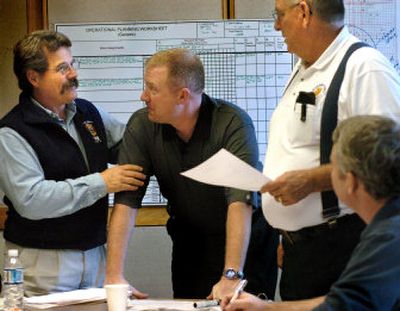Disaster response practiced

Rescuers from around Eastern Washington learned what to do when disaster strikes in recent classes that included a simulated weapons of mass destruction airstrike.
“The purpose is to take chaos and create order out of the chaos,” said Richard Andring, a private contractor who led some of the classes at Department of Emergency Management offices on North Rebecca St.
Representatives from emergency management, public health, hospitals, police departments, fire stations and other agencies went through training exercises to help them coordinate rescue efforts in the wake of disasters that include fires, earthquakes and terrorist attacks.
The students learned how to manage and support teams of rescuers during a simulated weapons of mass destruction airstrike – a plane flew over a food and wine festival at a park and dumped a pesticide on those attending.
The day before, the teams put together a plan for the event, something that probably didn’t include emergency response, but everyday logistics of a large, public event. The teams didn’t know there would be a simulated attack until the fourth day of the six-day exercise.
The students were learning about organizing public information, making sure the appropriate rescuers were on their way. Instructors would update the teams as to what was going on at the scene of the rescue, and the teams would respond to that information.
Instructors often gave the students bad information, since sometimes in an emergency, things get confusing and misinformation is passed along.
The teams – there were four of them, all participating in a the same simulated event – made sure they used pen and paper and filled out hard copies of forms, since in an emergency, sometimes there is no power for computers.
There were five counties participating in the classes: Spokane, Stevens, Whitman, Pend Oreille and Columbia.
It is hoped that the students will take the lessons they have learned back to their own departments and agencies and will be able to organize and create order until outside help can come.
Andring said there have been incident response teams in the area for more than 15 years.
“In Spokane, the approach is to provide a backbone,” he said. “You’ve got a lot of resources here.”
Stan Walthall of the Coast Guard Auxiliary was the public information officer for his team.
He said that he spent time collecting information to pass along to the different responding agencies and also worked with other public information agencies to decide what information should be released to the public.
Walthall was then pulled away for another briefing of the situation. The rescuers were going to decontaminate businesses around the scene and hospitals were getting ready to treat the victims.